Investing early in AI for language learning is a way to earn millions of users and revenue as Duolingo does. Or gain investors and cooperate with world-known companies (Amazon, Google, Uber) as Busuu does. But how do top market players use AI to solve online language learning challenges? What AI tools and algorithms have they applied? In this article, we’ll explain it all in detail.
Discuss your idea of creating an AI-powered language learning tool with Belitsoft's eLearning experts. Interested in adding innovative tools to your eLearning software? We offer assistance, including AI-based chatbot development services, and have the expertise to guide and support you.
Major Online Language Learning Challenges and Ways to Solve Them
To create your own language learning app, it's necessary to understand what major challenges online learners face and choose the tools to overcome them.
Find below the top 4 challenges in language learning with a short review of features solving these challenges. The features and tools based on AI will be described in detail later on.
1. Lack of motivation
Even highly motivated people are getting bored after several lessons.
The main reasons for it are too long lessons, boring exercises, unfitting difficulty level, insufficient rules explanation, or absence of personalization.
How to solve:
- Placement test to detect the current level and start learning from that point;
- Diversity of exercise types to alter different types of activities and avoid boredom;
- Smart notifications to remind learners about today's lesson at the best time;
- Gamification to create a competitive spirit and award for diligent learning;
- Personalized learning path to offer only relevant materials for studying.
2. Not covering grammar well
Intuitive learning is good at the beginning when grammar is simple and it's enough to focus on vocabulary. But once the topics get more complicated, learners need deeper explanations.
In the meanwhile, 20% of learners report not getting enough grammar instruction from the platform.
And without understanding grammar, a learner will always make the same mistakes.
So the task of a well-thought language learning app is to cover all the aspects of language learning.
How to solve:
- Scaffolded support to give on-demand explanation during exercises or in case of mistakes;
- Chatbots to offer a rule explanation upon learner’s request.
3. Poor knowledge retention
Language learning apps are aimed to teach fast.
For example, Duolingo states that 34 hours of studying using the app equals one semester at the university.
The problem is all newly learned information is easily forgotten if not repeated.
How to solve:
- Data-driven spaced repetition technique to repeat new information with certain intervals for better knowledge retention;
- Regular assessments to detect learners' knowledge gaps and address them.
4. Overcoming the language barrier
Most students are afraid to make mistakes and sound bad when speaking. Even when people meet natives they are afraid to test their skills.
Learning languages online helps overcome this fear by starting to practice with AI instead of a real person. Later on, learning techniques that involve other people can be added.
All the conversations are close to real-life scenarios to practice speaking skills that with high probability will be needed in real life.
How to solve:
- Speech recognition techniques to train learners to speak during the learning process
- Applying immersive learning with AR and VR to create real-life situations
- Social learning to enable learners to communicate with peers
Most of the mentioned tools that allow solving these top challenges are based on Artificial Intelligence. Let's see now how they work.
6 Key Applications of AI in Language Learning
By resolving major learners' problems and fears, the creators of AI-powered language learning programs make such software more appealing for users and as a result for investors.
Let's find out which AI tools you should consider for that.
Placement test
To offer learners the course of the difficulty level corresponding to their actual skills, provide them with a thoroughly designed placement test at the start of learning.
The AI-based placement test is not a series of questions predefined by admins. The system adjusts the difficulty of every new question based on your previous answer.
After a learner answers correctly, a more complex question comes next. In the case of a mistake, the next question will be simpler.
The purpose of a placement test is to evaluate a learner's knowledge level and detect weaknesses that shall be practiced first.
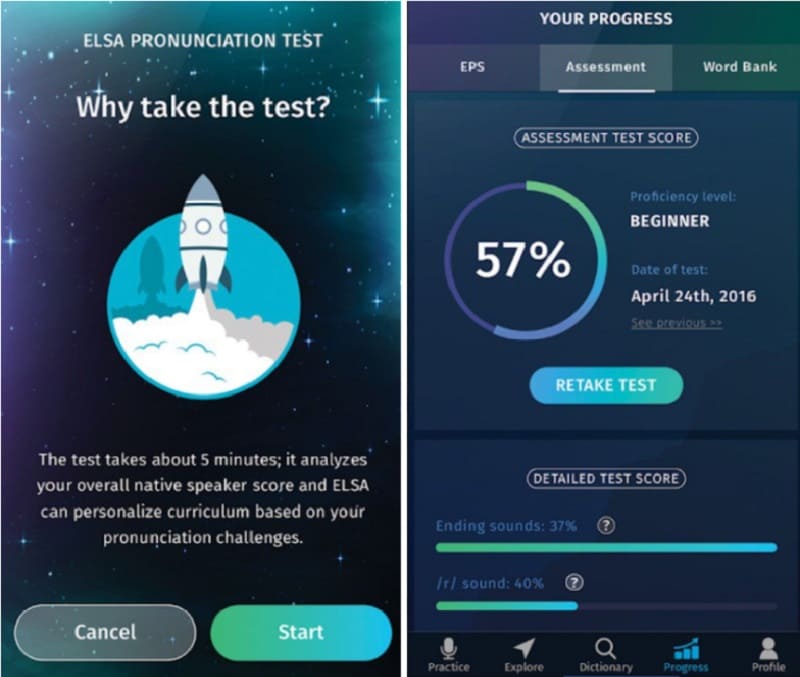 Elsa
Elsa
Сhatbots (text and voice)
Chatbots for communication practice is another useful application of AI-powered language learning apps.
It will imitate real-life conversation allowing learners to improve their communication skills.
The language learning chatbots use AI algorithms to understand the context of the conversation and answer in a unique way. It means that every learner gets a different answer for a similar inquiry.
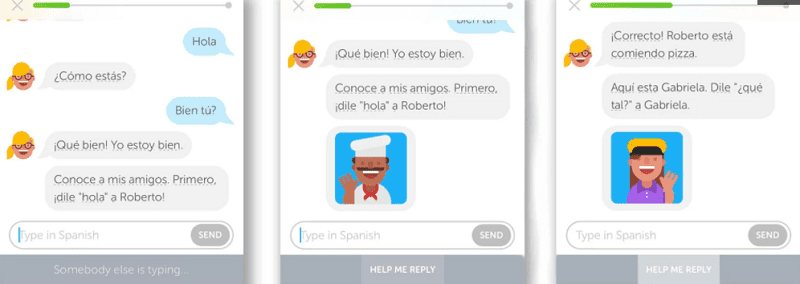 Duolingo
Duolingo
The latest trend is AI chatbots based on speech recognition for teaching the right pronunciation.
An AI-powered voice chatbot speaks with a learner in real-time. The conversations cover topics from everyday life.
A learner simply uses the mic of the smartphone, and the AI listens and assesses pronunciation instantly, without downtime.
Then AI scores a learner based on a benchmark (native speakers' voices) and highlights the mistakes. A learner can click on the sentence and get more detailed feedback on pronunciation, intonation, and fluency.
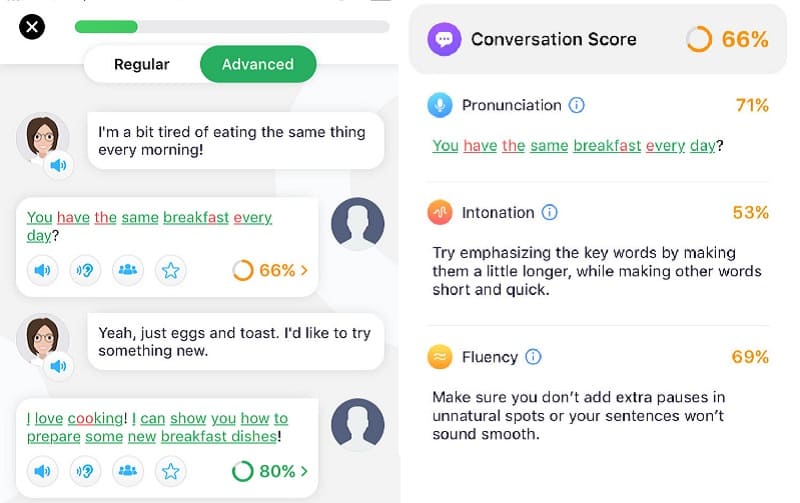 Elsa
Elsa
Personalized learning path
To satisfy and retain learners, the app must offer a personalized approach to learning.
The AI algorithm assesses each learner's strengths and weaknesses and provides a personalized set of learning materials.
Using AI in language learning helps to reduce the learning time thanks to a more immersive and tailored approach to learners' needs.
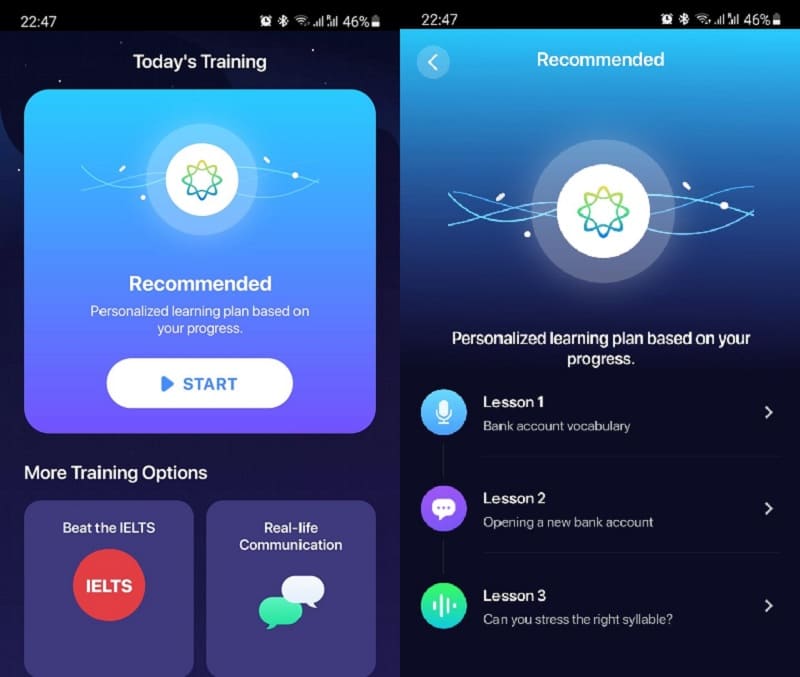 Elsa
Elsa
In addition, the algorithm applies a spaced repetition to ensure that learners repeat new information for long-term memorization.
AI-powered spaced repetition technique adjusts the time when a piece of content shall be revised based on the difficulty level of the mastered material.
Here is how AI-driven spaced repetition may look like for users.
Every topic has five difficulty levels. After completing all five levels, the topic is considered finished (highlighted with gold). But passed some time (defined by AI), the icon gets shattered, which means that the material needs to be reviewed.
 Duolingo
Duolingo
Automated assessment
The most advanced example of implementing AI for automated assessment is the Duolingo English Test. This test defines the language level according to the international standard benchmark.
AI technologies (namely, Machine Learning and Natural Language Processing) are used to:
- automatically create thousands of assessment tests;
- assess and grade complex answers;
- align the test results with CEFR language proficiency levels (A1 - C2);
- gather all information to count the final score;

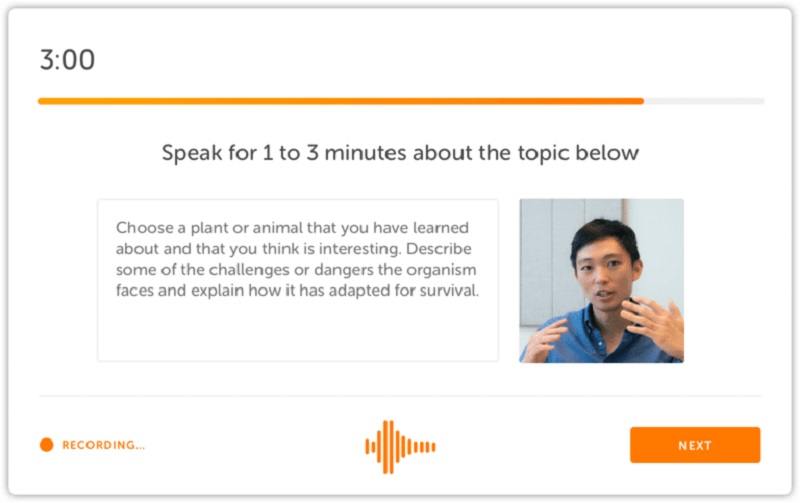
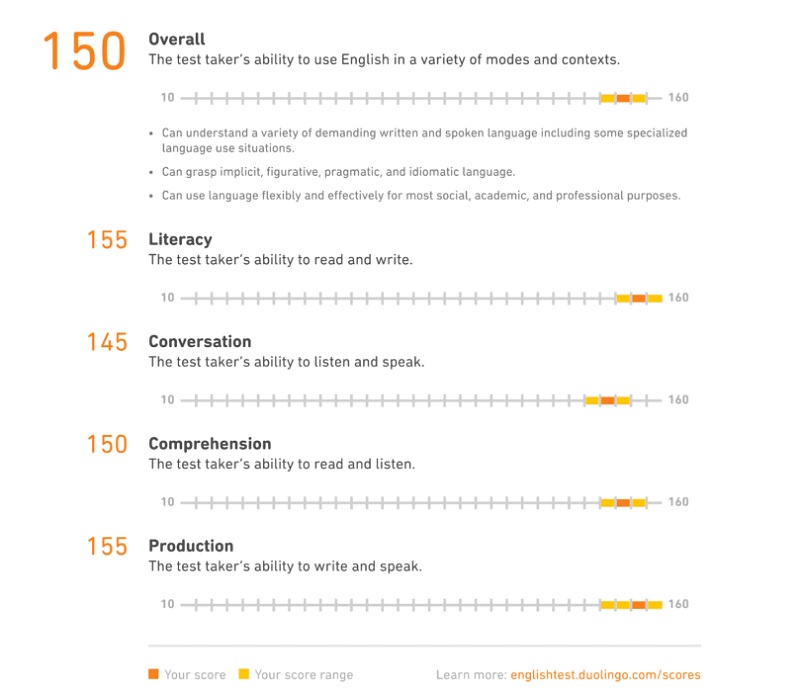 Duolingo
Duolingo
Proactive smart notifications
Notifications reminding to train skills allow learners not to deviate from the course and help the app retain users.
AI can be used to improve the effectiveness of app notifications. For that, it's necessary to figure out when to send notifications and what to tell every learner.
Having a daily activity log in the app, AI picks a time when to best send the reminder and also what to say in that reminder to return a learner back.
After applying AI-enabled notifications, Duolingo reported having big gains in terms of the number of people coming back.
 Duolingo
Duolingo
Scaffolded support
To assist a learner in the moment of a struggle or in the case of a mistake, it's smart to use short instructional videos, integrated tips, and dictionary articles.
They can be opened by tapping or hovering over the word and can show a rule explanation, pronunciation samples, or possible word forms.
 Duolingo
Duolingo
Benefits of AI in language learning
The described AI tools not only eliminate challenges in online learning but also bring obvious benefits to learners and consequently to software creators.
Adapting to the needs of learners
With AI integrated into language learning, the system collects multiple data about learners, their skills, interests, etc.
When analyzed, these data are used to make learning highly relevant to learners interests and tailored to their actual skills and expected goals.
As a result, learners can study at their own pace. AI-based language learning apps and platforms repeat topics and emphasize things that learners struggle with and engage them with the tasks they’re best at.
In case a language learning platform or app is used as a part of blended learning, AI data also gives detailed information about students performance and even predicts their future performance.
Providing instant feedback
The AI engine instantly grades tests and even evaluates essays automatically.
This allows learners to immediately analyze mistakes, repeat a topic, and probably make more tests to reinforce the acquired knowledge.
Getting feedback fast lowers the intensity of expecting the results.
Besides, it helps to detect weaknesses and address them effectively. The reason is when learners still remember test questions and their own answers, analyzing mistakes becomes more effective.
Producing smart content
A language learning app or platform usually stores learning content in large amounts.
Using this data, AI can generate bite-sized lessons that are relevant to a learner's knowledge level and interests.
The use of bite-sized lessons, also known as the microlearning approach, leads to better knowledge retention and high engagement of learners who don't get bored during short learning sessions.
New ways of perceiving information (visualization or simulation) can also be powered by AI, making the course more engaging and real-life.
Trial-and-error learning without the fear of failing
Making mistakes is normal for learning but still intimidating. Most learners start feeling ashamed or even scared.
AI in language learning won't criticize learners in front of the class. AI evaluates learners without judging them.
Redefining the role of teachers
Now the number one problem for teachers is the lack of time.
A large part of their teaching activity is focused on organizational tasks instead of students.
Thanks to AI, such administrative and repeated tasks as grading, assignments, grouping, etc can be automated.
Instead, teachers will be able to focus on learners and on teaching instead of spending valuable time on side tasks.
Top 5 AI-powered Language Learning Apps
Duolingo
An American language-learning website and mobile app, Duolingo is the most popular language-learning platform in the world. Its revenue was estimated to be $180 million in 2020. The total number of users is over 300 million.
Duolingo offers 106 different language courses in 38 languages. It's fully equipped with AI algorithms to offer each learner a customized learning experience.
With their language chatbots, Duolingo helps people learn a new language without the embarrassment that might happen by miscommunicating with a native speaker.
Thу application has got multiple awards. For example, it's included in TIME Magazine's 50 Genius Companies and named one of Forbes's "Next Billion-Dollar Startups 2019".
The AI features used by Duolingo:
- chatbots to imitate real-life communication with native speakers;
- the placement test to define the current skills level of a learner
- proactive reminders to notify smartly about the necessity to start learning;
- custom lessons to calibrate the difficulty level of exercises for a specific learner;
Monetization model:
The company uses a freemium model. The content is fully accessible without charge, although Duolingo also offers a premium service for a fee.
Memrise
A British language platform, Memrise is focused on the increase of knowledge retention by using spaced repetition of flashcards. The application won the best App winner award in Google Play Awards in 2017.
Memrise can help to learn 23 languages. Among their users, there are more than 50 million people in 189 countries. The company revenue as of 2020 was estimated to be about $23 million.
The peculiarity of the app is real-time object identification. This method means that users can take a photo of an object and feed it to the app to discover the name of the object in the target language.
Memrise was named as one of the Best App winners of the second edition of Google Play awards back in 2017.
The AI features used by Memrise:
- personalized learning activity to adjust the difficulty level and content relevance for each user;
- speech recognition function to practice pronunciation
- text chatbots to practice learner's vocabulary in conversational situations
Monetization model:
Memrise started as a free language app with premium paid features. Later the company shifted its business model to a full paid language app. The early learning courses and content is still available for free to let a learner try the app without paying.
Rosetta Stone
Created by the American EdTech company, the Rosetta Stone app is reported to have now a revenue of over $101 million and more than 515 thousand subscribers.
This language learning application helps users to learn 30 languages. This app uses the TruAccent speech engine to ensure users get the right articulation and uses images, text, and sound to teach words and grammar by spaced repetition method.
The company cooperated with the US Army offering a special military version of Arabic to help troops in the Middle East learn the language for conversations and phrases important in a military situation.
Rosetta Stone also won multiple awards from non-profit organizations, magazines, and the software industry.
The AI features used by Rosetta Stone:
- speech recognition to analyze learner's pronunciation of new words and provide instant feedback;
- real-time objects recognition to detect objects around a learner and learn new words.
Monetization model:
The company offers a 3-day free trial. Then a learner needs to pay for a subscription to access the content.
Busuu
Created in Spain and with headquarters in the UK, London, Busuu is focused on allowing users to interact with native speakers. The company was supposed to generate more than $40 million in revenues in 2020.
Busuu provides courses in 12 different languages on the web and mobile to over 100 million learners worldwide.
The peculiarity of Busuu is language learning based on the combination of AI-powered learning content, interaction with other learners, and one-to-one live tutoring with professional teachers.
The company also has Busuu for Organisations for universities and businesses. Organizations can give their students or employees access to Busuu Premium, track learner's progress, and use the app over time. Besides, organizations get personalized courses that include lessons about specific contexts. For example, Uber gets lessons with situations and vocabulary that a driver would encounter with their passengers.
In 2016, Busuu became a launch partner for Google Home Assistant, offering voice-activated lessons in Spanish.
A year later it launched a VR app for learning Spanish for the Oculus Gear and Oculus Go. And after one more year, Busuu launched a comprehension test for the Amazon Alexa platform.
The AI features used by Busuu:
- personalized learning to provide content that is relevant to learners interests, goals, and skills;
- grammar training tool to review rules on-demand and practice weaknesses
- vocabulary training tool to timely train vocabulary for better retention
Monetization model:
Learners can sign up for free, or subscribe to a Premium membership to unlock further features like advanced grammar lessons, Offline Mode, McGraw-Hill Education certification or our adaptive Vocabulary Trainer.
Babel
Babel is a German language learning app and eLearning platform with an office in the US. The company revenue as of 2020 equaled $129 million. The number of users surpasses 20 million.
Babel offers courses in 14 languages. In 2016, Fast Company recognized it as the most innovative company in education.
Babbel learning focuses on real-life situations by offering interactive dialogues. Curated review sessions reinforce previously learned material by bringing it back in new contexts.
The AI features used by Busuu:
- speech recognition technology to build correct pronunciation;
- personalized learning activities to engage learners;
- review manager tool to enhance knowledge retention based on spaced repetition method.
Monetization model:
After launching the first free beta version, Babbel's founders upgraded the app a year later and decided against an advertising and mixed-finance model (freemium), opting for paid content. Learners can choose among 4 subscription plans by course duration.
3 Everyday AI Tools from Google Available for All Language Learners
Everyone can try the basics of using AI for language learning without a specific application, AI-powered LMS or LXP.
Just make sure that you have added English to the list of languages in their smartphone or PC settings. It’s necessary so that the system could understand and transcribe the learner’s speech.
1. Google Docs speech recognition
Google Docs has added the possibility of typing with voice. This voice recognition feature is a free and mobile-friendly tool. It can assist in conversational activities. Learners can use it to evaluate the intelligibility of their speech.
2. Interacting with Google Assistant
Google Assistant is a perfect tool to train speaking and listening skills. A language learner can ask the assistant simple questions such as ‘What is the latest news?’, ‘What’s the weather like?’, ‘What are the best TV shows to watch for foreigners?’, etc.
This is a great way to test the intelligibility of pronunciation as well as listening and comprehension skills.
3. Using Google Maps to practice directions
Tools with integrated AI are not only helpful for practicing pronunciation but also for developing speaking skills.
Google Maps is a navigation, mapping app not meant for language learning. But when you study directions, names of different places, and how to get somewhere, using this app is highly helpful.
To start with, a learner can study the basic commands such as: turn right/left, cross the street, next to, go straight ahead, opposite to, etc. list nearby places.
After that, learners can practice their speaking capabilities by telling how to go from their location to the places listed.
Takeaway
There are over 1 bn people in the world learning a language. And over 56$ bn is the actual size of the language learning market. So every new startup and EdTech company has a chance to succeed and get a slice of the market.
To stand out from the competition and succeed, it's wise to use the benefits of Artificial Intelligence in Education.
For effective deployment of AI, the early start is critically important. So creating a language learning app, consider which AI tools you will apply.
Rate this article
Recommended posts
Portfolio

Our Clients' Feedback


















.jpg)
.jpg)
![Artificial Intelligence in Education [Ultimate Knowledge Hub]](/uploads/images/blog/posts/previews/image_163177848252-image(600x250-crop).jpg)
.jpg)
.jpg)
.jpg)
.jpg)
.jpg)
.jpg)
.jpg)
.jpg)
![How to Create a Language Learning App [The Ultimate Guide!]](/uploads/images/blog/posts/previews/image_155352483594-image(600x250-crop).png)
.jpg)
.jpg)
.jpg)
![Integrate Your CRM with LMS to Increase Sales [Start now!]](/uploads/images/blog/posts/previews/image_162030700147-image(600x250-crop).jpg)
.jpg)
.jpg)
.jpg)
.jpg)
.jpg)
.png)
.jpg)
.jpg)
.jpg)
.png)
.jpg)
.jpg)
.jpg)
.jpg)
.jpg)
.jpg)
.jpg)
.jpg)
.jpg)
.jpg)
.jpg)
.jpg)
.jpg)
.jpg)
.jpg)
.jpg)
.jpg)
.jpg)
.jpg)
.jpg)
.jpg)
.jpg)
.jpg)
.jpg)
.jpg)
.jpg)
.jpg)
.jpg)
.jpg)
.png)
.png)
.png)





















We have been working for over 10 years and they have become our long-term technology partner. Any software development, programming, or design needs we have had, Belitsoft company has always been able to handle this for us.
Founder from ZensAI (Microsoft)/ formerly Elearningforce